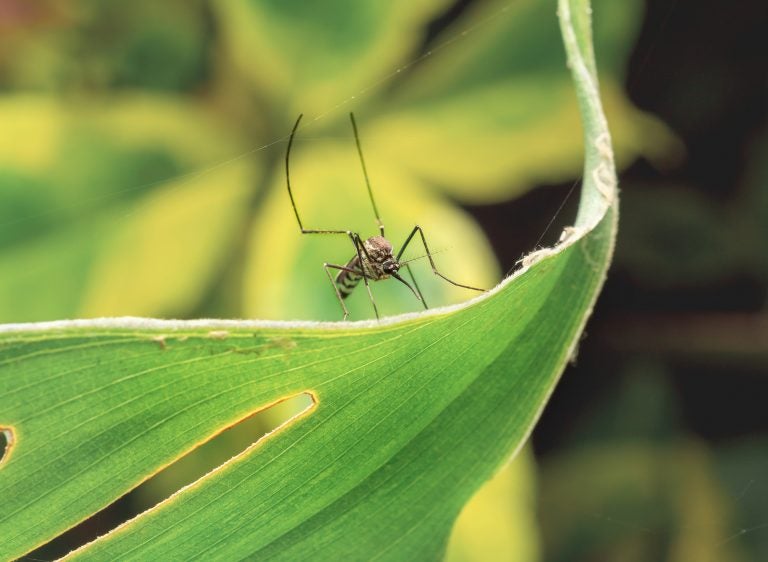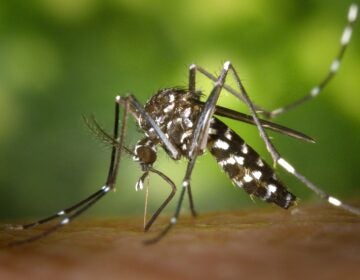After a wet spring, Pa. DEP monitors for West Nile virus. Will this summer be bad?
Last year was one of the worst on record for West Nile in Pennsylvania. The number of cases jumped to 130, from 20 in 2017, and eight people died.

Close up of Aedes Aegypti Mosquito resting on the leaf in garden. Aedes is a genus of mosquitoes transmit serious diseases, including dengue fever, yellow fever, the Zika virus and chikungunya. (Poravute Siriphiroon/BigStock)
Last year was one of the worst on record for West Nile virus in Pennsylvania. The number of cases jumped to 130, from 20 in 2017, and eight people died.
Erika Machtinger, an assistant professor of veterinary entomology at Penn State, says last year’s outbreak of West Nile — which is spread by mosquitoes — was the result of record rainfall and above-average temperatures.
“The more standing water there is, the more there is for them to develop in. And especially if it’s warm, they can develop faster,” said Machtinger. The virus replicates more quickly in warmer temperatures.
The Centers for Disease Control reports that vector-borne diseases — those spread by mosquitoes, ticks, and fleas — more than tripled in the United States since 2004. Changes in land use have brought humans more closely in contact with the creatures that carry these diseases. Changes in weather, such as heavier rainfall and higher average temperatures, are creating new habitat for them to proliferate.
“West Nile virus is far and away our most common mosquito-borne disease, and second in the nation really to Lyme disease,” Machtinger said. “But to put that in perspective, we have an estimated 330,000 cases of Lyme disease in the United States a year and under 3,000 West Nile virus.”
Pennsylvania has one of the highest incidence rates for Lyme disease in the country, although last year showed a slight drop in the number of reported cases. According to the state Department of Health, there were close to 12,000 reported cases of Lyme in 2017 and about 10,000 in 2018.
Lyme disease, which is transmitted by black-legged ticks, tends to be most prevalent in wooded areas. Urban environments like Philadelphia, however, can provide prime habitat for mosquito breeding. When rainwater pools in containers like discarded tires, gutters, birdbaths, and flower pots, it creates microhabitats in which insects can thrive.
After another rainy spring, should we be ready for an onslaught this summer? Keith Price, a microbiologist with the state Department of Environmental Protection, said so far, no.
“This time last year, we had 75 positive mosquitoes confirmed,” he said. “Right now, we have zero.”
Price attributes the change to cooler temperatures at the start of the season than we had last year. DEP tests for the virus on a weekly basis in 37 counties throughout the state, including Philadelphia. If enough mosquitoes test positive in a given area, an insecticide called pyrethroid may be sprayed into the air and on select vegetation. The chemical is diluted and considered to be low-risk to humans and the environment.
Most of the time, people infected with West Nile virus do not show symptoms. Twenty percent of those infected develop flu-like symptoms, such as fever, vomiting, and body aches. Less than one percent of cases lead to more severe illness, like encephalitis or meningitis.
To protect yourself, the state Department of Health recommends using insect repellent with DEET and getting rid of containers of standing water.
“If you’re breeding them, you’re feeding them,” said Price.
WHYY is your source for fact-based, in-depth journalism and information. As a nonprofit organization, we rely on financial support from readers like you. Please give today.




